In order to reduce unnecessary data transmissions from Internet of Things (IoT) sensors, this paper proposes a multivariate time series prediction-based adaptive data transmission period control (PBATPC) algorithm for IoT networks. Based on the spatio-temporal correlation between multivariate time series data, we developed a novel multivariate time series data encoding scheme utilizing the proposed time series distance measure ADMWD
Composed of two significant factors for a multivariate time series prediction, i.e., the absolute deviation from the mean (ADM) and the weighted differential distance (WD), the ADMWD considers both the time distance from a prediction point and a negative correlation between the time series data concurrently.
Utilizing the convolutional neural network (CNN) model, a subset of IoT sensor readings can be predicted from encoded multivariate time series measurements, and we compared the predicted sensor values with actual readings to obtain the adaptive data transmission period. Extensive performance evaluations show a substantial performance gain of the proposed algorithm in terms of the average power reduction ratio (approximately 12%) and average data reconstruction error (approximately 8.32% MAPE). Finally, this paper also provides a practical implementation of the proposed PBATPC algorithm via the HTTP protocol under the IEEE 802.11-based WLAN network.
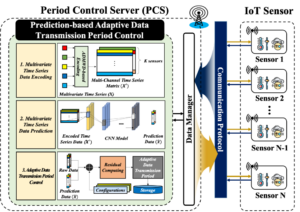
Authors: Seyeon Kim (KAIST), Kyungmin Bin (SNU), Sangtae Ha (CU Boulder), Song Chong (KAIST)
Abstract:
DVFS(dynamic voltage and frequency scaling) is a system-level technique that adjusts voltage and frequency levels of CPU/GPU at runtime to balance energy efficiency and high performance. DVFS has been studied for many years, but it is considered still challenging to realize a DVFS that performs ideally for mobile devices for two main reasons: i) an optimal power budget distribution between CPU and GPU in a power-constrained platform can only be defined by the application performance, but conventional DVFS implementations are mostly application-agnostic; ii) mobile platforms experience dynamic thermal environments for many reasons such as mobility and holding methods, but conventional implementations are not adaptive enough to such environmental changes. In this work, we propose a deep reinforcement learning-based frequency scaling technique, zTT. zTT learns thermal environmental characteristics and jointly scales CPU and GPU frequencies to maximize the application performance in an energy-efficient manner while achieving zero thermal throttling. Our evaluations for zTT implemented on Google Pixel 3a and NVIDIA JETSON TX2 platform with various applications show that zTT can adapt quickly to changing thermal environments, consistently resulting in high application performance with energy efficiency. In a high-temperature environment where a rendering application with the default mobile DVFS fails to keep producing more than a target frame rate, zTT successfully manages to do so even with 23.9% less average power consumption.
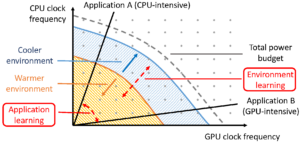
<The purpose and impact of learning in zTT>
(Figure) Figure illustrates the purpose and impact of learning in zTT. The lattice points within the total power budget curve for a mobile device represent all available CPU/GPU power consumption combinations. The graph shows that the better the cooling, the more combinations are usable, thus providing better performance for an application. To find out the best possible combination at the moment, zTT learns the environment and application performance.
Graph neural networks (GNNs) process large-scale graphs consisting of a hundred billion edges. In contrast to traditional deep learning, unique behaviors of the emerging GNNs are engaged with a large set of graphs and embedding data on storage, which exhibits complex and irregular preprocessing. We propose a novel deep learning framework on large graphs, HolisticGNN, that provides an easy-to-use, nearstorage inference infrastructure for fast, energy-efficient GNN processing. To achieve the best end-to-end latency and high energy efficiency, HolisticGNN allows users to implement various GNN algorithms and directly executes them where the actual data exist in a holistic manner. It also enables RPC over PCIe such that the users can simply program GNNs through a graph semantic library without any knowledge of the underlying hardware or storage configurations. We fabricate HolisticGNN’s hardware RTL and implement its software on an FPGA-based computational SSD (CSSD). Our empirical evaluations show that the inference time of HolisticGNN outperforms GNN inference services using high-performance modern GPUs by 7.1× while reducing energy consumption by 33.2×, on average.
학과뉴스링크: https://ee.kaist.ac.kr/en/press/22890/
학회링크: https://www.usenix.org/conference/fast22/presentation/kwon
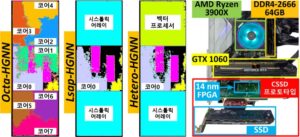
Authors: Hyeryung Jang, Hyungseok Song, and Yung Yi
Journal: IEEE/ACM Transactions on Networking, 2022 (Early Access)
Abstract
본 연구는 센서 네트워크, 소셜 네트워크와 같이 여러 노드들이 서로 다른 정보를 가지고 공간적으로 분리되어 있는 시스템에서의 효율적인 통신 방법에 대한 연구이다. 이러한 시스템에서 시스템 내의 노드들은 서로간의 통계적 데이터 관계성과 물리적 관계성을 가지고 있으며, 효율적인 통신을 위해서는 데이터를 통한 학습의 정확도와 통신에 필요한 메시지 전달 비용을 모두 고려해야한다. 이러한 네트워크 시스템의 분석을 위하여 우리는 이 시스템을 머신러닝 프레임워크 중 하나인 그래피컬 모델로 모델링하고, 여러 대표적인 메시지 전달 메커니즘들에 대해 이론적 분석과 시뮬레이션 결과를 통하여 제안된 방법이 효율적임을 보인다.

Figure. 물리적인 관계성과 데이트 관계성이 다른 네트워크 그래프 예시. (Left) 물리적 관계성 그래프 (Middle) 통계적 데이터 관계성 그래프 (Right) 노드들간의 메시지 전달 비용을 고려한 통계적 데이터 관계성 그래프
Various automated eating detection wearables have been proposed to monitor food intakes. While these systems overcome the forgetfulness of manual user journaling, they typically show low accuracy at outside-the-lab environments or have intrusive form-factors (e.g., headgear). Eyeglasses are emerging as a socially-acceptable eating detection wearable, but existing approaches require custom-built frames and consume large power. We propose MyDJ, an eating detection system that could be attached to any eyeglass frame. MyDJ achieves accurate and energy-efficient eating detection by capturing complementary chewing signals on a piezoelectric sensor and an accelerometer. We evaluated the accuracy and wearability of MyDJ with 30 subjects in uncontrolled environments, where six subjects attached MyDJ on their own eyeglasses for a week. Our study shows that MyDJ achieves 0.919 F1-score in eating episode coverage, with 4.03× battery time over the state-of-the-art systems. In addition, participants reported wearing MyDJ was almost as comfortable (94.95%) as wearing regular eyeglasses.
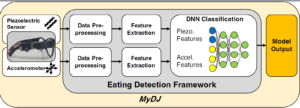
The importance of online education has been brought to the forefront due to COVID. Understanding students’ attentional states are crucial for lecturers, but this could be more difficult in online settings than in physical classrooms. Existing methods that gauge online students’ attention status typically require specialized sensors such as eye-trackers and thus are not easily deployable to every student in real-world settings. To tackle this problem, we utilize facial video from student webcams for attention state prediction in online lectures. We conduct an experiment in the wild with 37 participants, resulting in a dataset consisting of 15 hours of lecture-taking students’ facial recordings with corresponding 1,100 attentional state probings. We present PAFE (Predicting Attention with Facial Expression), a facial-video-based framework for attentional state prediction that focuses on the vision-based representation of traditional physiological mind-wandering features related to partial drowsiness, emotion, and gaze. Our model only requires a single camera and outperforms gaze-only baselines.

저자:
김우중, 윤찬현(지도교수)
Abstract:
딥 러닝 기반 위성 이미지 분석 및 이를 위한 학습 시스템은 지상 물체의 정교한 분석 능력을 향상시키는 방향으로 새로운 기술들이 개발되고 있다. 이러한 기술들 기반에서 위성 이미지 분석 및 학습 과정에 설명 가능한 DNN 모델을 적용하기 위해 새로운 가속 스케줄링 메커니즘을 제안하고자 한다. 특히, 기존의 DNN 가속 기법들로는 설명 가능한 DNN 모델의 연산 복잡성과 위성 이미지 분석 및 재학습 비용으로 인해 연산 처리 및 서비스 측면에서의 성능 저하를 초래한다. 본 논문에서는 이러한 성능 저하를 극복하기 위해 위성 이미지 분석 및 재학습 프로세스에서 설명 가능한 DNN 가속을 위한 협력 스케줄링 체계를 제안한다. 이를 위해 설명 가능한 DNN 가속화에 필요한 최적화된 처리 시간과 비용을 도출하기 위한 지연 시간 및 에너지 비용 모델링을 정의한다. 이를 토대로, FPGA-GPU 가속 시스템에서 설명 가능한 DNN의 계층 수준 관리를 통한 스케줄링 기법을 제안하며, 해당 기법을 통해 연산 처리 비용을 최소화할 수 있음을 확인하였다. 또한, 재학습 과정을 가속화하는 데 있어 신뢰 임계값과 준지도 학습 기반 데이터 병렬화 체계를 적용한 적응형 Unlabeled 데이터 선택 기법을 제안한다. 실험 성능 평과 결과, 제안된 기법이 지연 시간 제약을 보장하는 동시에 기존 DNN 가속 시스템의 에너지 비용을 최대 40%까지 절감한다는 것을 확인하였다.
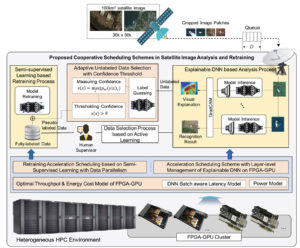
논문 정보:
Kim, Woo-Joong, and Chan-Hyun Youn. “Cooperative Scheduling Schemes for Explainable DNN Acceleration in Satellite Image Analysis and Retraining.” IEEE Transactions on Parallel and Distributed Systems 33.7, 2021, p.1605-1618.
In cloud machine learning (ML) inference systems, providing low latency to end-users is of utmost importance. However, maximizing server utilization and system throughput is also crucial for ML service providers as it helps lower the total-cost-of-ownership. GPUs have oftentimes been criticized for ML inference usages as its massive compute and memory throughput is hard to be fully utilized under lowbatch inference scenarios. To address such limitation, NVIDIA’s recently announced Ampere GPU architecture provides features to “reconfigure” one large, monolithic GPU into multiple smaller “GPU partitions”. Such feature provides cloud ML service providers the ability to utilize the reconfigurable GPU not only for large-batch training but also for small-batch inference with the potential to achieve high resource utilization. In this paper, we study this emerging GPU architecture with reconfigurability to develop a high-performance multi-GPU ML inference server. Our first proposition is a sophisticated partitioning algorithm for reconfigurable GPUs that systematically determines a heterogeneous set of multi-granular GPU partitions, best suited for the inference server’s deployment. Furthermore, we co-design an elastic scheduling algorithm tailored for our heterogeneously partitioned GPU server which effectively balances low latency and high GPU utilization.
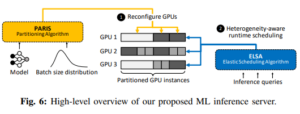
Yunseong Kim, Yujeong Choi, and Minsoo Rhu, “PARIS and ELSA: An Elastic Scheduling Algorithm for Reconfigurable Multi-GPU Inference Servers,” The 59th ACM/ESDA/IEEE Design Automation Conference (DAC), San Francisco, CA, Jul. 2022
A point cloud is a collection of points, which is measured by time-offlight information from LiDAR sensors, forming geometrical representations of the surrounding environment. With the algorithmic success of deep learning networks, point clouds are not only used in traditional application domains like localization or HD map construction but also in a variety of avenues including object classification, 3D object detection, or semantic segmentation. While point cloud analytics are gaining significant traction in both academia and industry, the computer architecture community has only recently begun exploring this important problem space. In this paper, we conduct a detailed, end-to-end characterization on deep learning based point cloud analytics workload, root-causing the frontend data preparation stage as a significant performance limiter. Through our findings, we discuss possible future directions to motivate continued research in this emerging application domain.
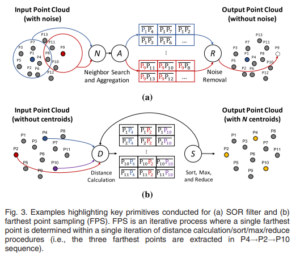
Bongjoon Hyun, Jiwon Lee, and Minsoo Rhu, “Characterization and Analysis of Deep Learning for 3D Point Cloud Analytics”, IEEE Computer Architecture Letters, Jul. 2021
Graph neural networks (GNNs) can extract features by learning both the representation of each objects (i.e., graph nodes) as well as the relationship across different objects (i.e., the edges that connect nodes), achieving state-of-the-art performance on a wide range of graph-based tasks. Despite its strengths, utilizing these algorithms in a production environment faces several key challenges as the number of graph nodes and edges amount to several billions to hundreds of billions scale, requiring substantial storage space for training. Unfortunately, existing ML frameworks based on the in-memory processing model significantly hamper the productivity of algorithm developers as it mandates the overall working set to fit within DRAM capacity constraints. In this work, we first study state-of-the-art, largescale GNN training algorithms. We then conduct a detailed characterization on utilizing capacity-optimized non-volatile memory solutions for storing memoryhungry GNN data, exploring the feasibility of SSDs for large-scale GNN training

Yunjae Lee, Youngeun Kwon, and Minsoo Rhu, “Understanding the Implication of Non-Volatile Memory for Large-Scale Graph Neural Network Training”, IEEE Computer Architecture Letters, Jul. 2021









